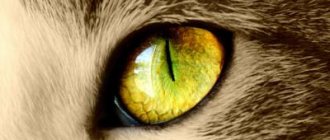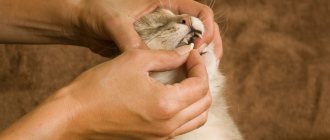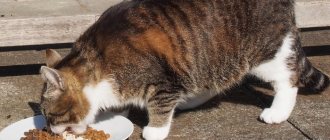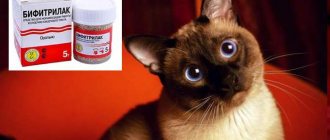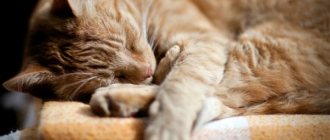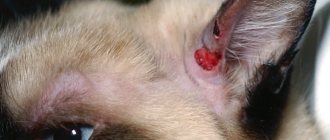Reasons why gastritis develops in cats
Various factors contribute to the development of feline gastritis. This may be a primary disease caused by poor diet. But it also develops against the background of another pathology in the form of a complication, despite proper care and quality of food.
Gastritis in cats
A sudden change in diet
Cats find it painful to switch to a new diet. Especially if good store-bought food is replaced by low-quality food (table waste, meat scraps, etc.). But my stomach is not used to such food. Until the production of new enzymes improves, inflammation will occur.
Incorrect feed supply
Hot or cold food can provoke irritation of the mucous membrane. The destructive effect increases if the cat quickly absorbs food. People also “sin” by treating the cat to meat and fish dishes that contain salt, spices, and onions from the common table. These ingredients are unacceptable for a cat's stomach.
You also need to monitor the quality of food, be it meat and fish or special food for cats. Some owners feed their cats meat or fish waste of dubious quality. Often these products are not the freshest.
Overfeeding
Many owners rush to feed their pet on demand. Many breeds have a genetic predisposition to excess weight, and at home the risk doubles. Due to the large volume of food, gastric juice does not have time to be produced, and digestion is disrupted. The walls of the stomach stretch, and the inflammatory process begins.
Systematic overfeeding and improper eating are the main causes of feline gastritis
Other reasons
Other factors that provoke inflammation of the gastric mucosa:
- poisoning with toxic substances;
- infectious diseases;
- worms;
- systematic ingestion of wool;
- diseases of the teeth and oral cavity;
- taking medications.
Reference! A cat may develop gastritis after antibiotics as a reaction to decreased immunity.
Form of the disease and symptoms
Distemper in cats: symptoms and treatment at home
Gastritis in cats occurs in different forms. It can develop suddenly, or it can last for years in a chronic form.
Chronic form
Characterized by a violation of the production of gastric juice (deficiency or excess). In most cases it is asymptomatic. Occasionally, the animal vomits, which is attributed to the stomach being clogged with hair. Lack of treatment leads to fragility of blood vessels, which can lead to hemorrhage in the stomach.
Acute form
In case of acute gastritis in a cat, the symptoms are vivid, treatment should be started as quickly as possible. The mucous membrane swells, inflammation begins. The first sign is loss of appetite, stool upset, vomiting, lethargy and apathy. As the disease progresses, a putrid odor appears from the mouth, a yellow coating forms on the tongue, and the mucous membranes turn pale. The fur takes on an unkempt appearance and the animal sheds.
Faded and unkempt fur may indicate the development of gastritis.
Uremic gastritis
This form is not associated with poor nutrition and damage to the mucous membranes of the stomach. This is a complication of kidney failure, which often develops in older pets.
Due to impaired kidney function, toxic nitrogenous compounds accumulate in the blood. In the later stages, they leave the body through the skin and mucous membranes, and provoke uremic gastritis.
Accompanied by loss of appetite, apathy, severe thirst. Sometimes the cat is bothered by diarrhea, vomiting, and there is a strong ammonia smell from the mouth.
Attention! In severe cases of uremic gastritis, the mucous membranes of other organs are affected, blood circulation is impaired, and vision deteriorates.
Clinical symptoms
The following pathological symptoms develop in various diseases:
- refusal to eat or decreased appetite;
- difficult to chew, painful to swallow;
- yellow or brown deposits on teeth;
- coating or ulcers on the tongue;
- salivation;
- stench from the mouth;
- vomit;
- constipation;
- diarrhea;
- bloating;
- untidiness of coat;
- aggression.
Depending on the cause of the disease, other pathological signs may occur.
How to diagnose gastritis in a cat
Rhinotracheitis in cats: symptoms and treatment at home
It is impossible to diagnose gastritis in a cat based on its symptoms, since they are similar to the signs of other diseases. A veterinarian can give an accurate answer after a comprehensive diagnosis. The doctor examines the gastric juice for hydrochloric acid content. A blood test is taken, and urine biochemistry is also performed to detect chronic renal failure or urolithiasis.
Endoscopy is necessary to assess the condition of the mucosa. But this procedure is not available in all clinics.
Sawstones in the stomach
This is the name given to hairballs in the stomach, typical of cats. This problem is especially common among owners of long-haired breeds. Wool balls interfere with the normal passage and digestion of food masses and can cause intestinal blockage.
The symptoms are similar to those of gastritis (deterioration of appetite and vomiting are especially characteristic). In mild cases, Vaseline oil helps remove fur from the stomach, but surgery is often necessary.
Necessary treatment
If symptoms are detected, you should take your pet to a veterinarian. If this is not possible, the cat’s stomach is treated at home. Vomiting and diarrhea can lead to dehydration. Replenish the loss with the drug "Regidron". The sachet is diluted in a liter of water; you need to feed the cat the resulting solution several times a day using a pipette or syringe.
Cystitis in a cat: symptoms and treatment at home
For constipation, it is necessary to help cleanse the intestines. For this purpose, an adult animal is given 2 ml of Duphalac. If the kitten is sick, the dosage is reduced to 0.5-1 ml.
Drug therapy
In severe cases, the veterinarian prescribes medications:
- antiemetics - Cerucal, Zofran;
- to reduce acidity - Omeprazole;
- antispasmodics - “No-Shpa”;
- adsorbents - “Enterosgel”;
- before meals to coat the walls of the stomach - “Almagel”, “Phosphalugel”.
Important! Each medication, as well as its dosage and course duration, is prescribed by a veterinarian based on the results of the examination, the weight and age of the pet.
Medicines are prescribed strictly by a veterinarian; self-medication is not allowed.
Prognosis for cats with VKD
Inflammatory bowel disease can only be controlled, not cured. Usually the prognosis in cases of severe illness is poor.
Be patient with the form of treatment suggested by your veterinarian and strictly adhere to the recommendations. Control depends on the correct selection of diet, dosages of medications, careful monitoring by the veterinarian and owner, and the absence of other concomitant diseases.
Read reviews about our veterinary center. Call the number and schedule a consultation right now or request a call back. (c) Veterinary center for the treatment and rehabilitation of animals “Zoostatus”. Varshavskoe highway, 125 building 1.
What to feed a cat with this disease
On the first day of exacerbation, a hunger strike is indicated. Next, the veterinarian prescribes a therapeutic diet. You need to feed 4-5 times a day, bring the food to a puree consistency, grind it or chop it finely. Cartilage, bones, and rough skin are excluded from the diet. It is highly not recommended to give sausage, fried and fatty foods from the table.
Feeding with store-bought food, especially soft canned food, is not prohibited. Dry food is first soaked in hot water and then ground into a paste.
With low acidity, give cottage cheese, kefir, yogurt, eggs, meat and fish soups, with high acidity - porridge, boiled meat, lean fish. Fresh carrot juice is also added to food.
Important! Hot food irritates the stomach lining, so all food should be at room temperature.
What are the prognosis for this disease?
In acute gastritis, the outcome is favorable if treatment is started in a timely manner. In the chronic form, the prognosis depends on the cause that provoked the disease. The uremic form is not treated, as it develops as a complication of chronic renal failure. Periodic therapy and diet make it easier and prolong the life of your pet.
If eosinophilic gastritis develops with the appearance of infiltrates on the walls of the stomach, then recovery in most cases does not occur. The progressive disease destroys cells and tissues of other organs. If treated persistently, remission can be achieved.
Causes of the disease: osinophilic gastritis
Eosinophilic gastritis in dogs and cats can develop due to the following reasons:
1. The predominance of artificial components in animal feed. 2. Allergy to any food products. 3. Side effects of medications. 4. Inflammation of the gastrointestinal tract. 5. Diseases caused by parasites (trichocephalosis). 6. Hypereosinophilia syndrome. In some cases, eosinophilic gastritis of unknown etiology occurs. Diseases and recommendations for the Rottweiler
Eosinophilic gastritis is manifested by periodic vomiting, diarrhea and weight loss. In addition, blood may be detected in the stool. If the disease occurs as a result of hypereosinophilia, enlarged peripheral lymph nodes may be detected, as well as an increase in the size of the liver and spleen.
Disease prevention
To prevent inflammation of the gastric mucosa, it is recommended to follow the following preventive measures:
- give food at room temperature;
- monitor the quality of feed;
- do not give human food with added salt, spices, onions, garlic;
- comb the cat so that it does not swallow fur;
- give antiparasitic drugs every 3 months;
- Once a year, take your pet to the veterinarian for examination and testing.
Attention! Prevention will not protect against some forms of feline gastritis that develop against the background of other pathologies.
Gastritis in cats is caused by various factors, especially poor nutrition. If you consult a veterinarian in a timely manner and follow a diet, a favorable outcome is guaranteed. But it is better to provide your pet with high-quality nutrition and follow other preventive measures so as not to encounter the disease.
Clinical tests
For diseases of the gastrointestinal tract, it is mandatory to submit a stool test for helminths and scatology. This will help identify parasites and suspect digestive disorders.
X-ray examination using contrast helps to identify areas of obstruction, the presence of tumors and foreign bodies.
Ultrasound allows you to diagnose diseases as accurately as possible and accurately establish a diagnosis.
For infectious diseases of the gastrointestinal tract, culture of vomit, gastric lavage and feces to determine the pathogen
